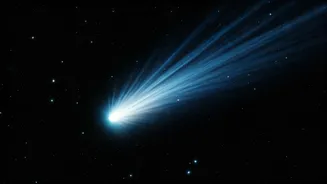An Interstellar Visitor
Comet 3I/Atlas, officially designated as C/2019 Q4 (ATLAS), is an interstellar comet. This means it originated outside of our solar system. Unlike comets
that orbit the Sun, 3I/Atlas embarked on a journey through our celestial neighborhood from another star system. Its discovery, made by the ATLAS (Asteroid Terrestrial-impact Last Alert System) survey in late 2019, was a significant event. It was only the second interstellar object ever observed passing through our solar system, following 'Oumuamua. The unique nature of 3I/Atlas has provided scientists with a rare opportunity to study the composition and characteristics of comets from other star systems, offering valuable insights into the formation and evolution of planetary systems beyond our own.
Unusual Orbital Path
Unlike comets originating within our solar system, which follow elliptical orbits around the Sun, 3I/Atlas displayed a hyperbolic trajectory. This indicated that it wasn't bound to the Sun's gravity and was merely passing through. The comet's path took it on a high-speed journey through our solar system, making its encounter with us a fleeting event. The speed and direction of 3I/Atlas provided astronomers with clues about its origin and the environments it traversed before entering our cosmic neighborhood. Tracking its path was crucial in determining its trajectory and gathering data about its composition as it journeyed through our solar system, which assisted astronomers in comparing it to comets from our solar system.
A Fading Brightness
When Comet 3I/Atlas was first observed, it was exceptionally bright, leading astronomers to believe it could become a spectacular sight in the night sky. However, as it approached the Sun, its brightness unexpectedly began to fade. This behavior, which baffled astronomers, was due to the comet's nucleus breaking apart. Although the exact reasons behind this breakup are still being investigated, some theories suggest that the comet's icy composition might have been unstable or that thermal stresses from the Sun caused it to disintegrate. The fading brightness served as a reminder of the fragility of comets and the unpredictable nature of these celestial bodies. The situation provided valuable data for studying the composition and evolution of comets.
Composition and Analysis
Although the comet's disruption made detailed observation challenging, scientists employed various techniques to study its composition. They examined the light emitted and reflected by the comet, analyzed its dust and gas content, and tried to determine the types of materials present. Initial observations showed that 3I/Atlas contained a mix of water ice, carbon dioxide, and other volatile substances. Scientists were also interested in the presence of organic compounds, which could provide insights into the building blocks of life. Studying the composition of interstellar comets is vital because it offers a direct look into the materials present in other star systems and can tell us about their history. This research can help us compare the building blocks of other systems with our own.
Astronomical Significance
The observation of Comet 3I/Atlas provided valuable insights into interstellar objects and their role in the universe. Such objects, originating from other star systems, serve as messengers carrying information about the environments from which they originated. Studying 3I/Atlas has allowed scientists to compare it with comets originating in our solar system, which helps in understanding the diversity of cometary populations and the processes that shape them. These studies help to understand planet formation and the distribution of materials in other star systems. In the future, as technology advances, the study of interstellar objects will likely become even more precise, and scientists will learn more about the universe.












